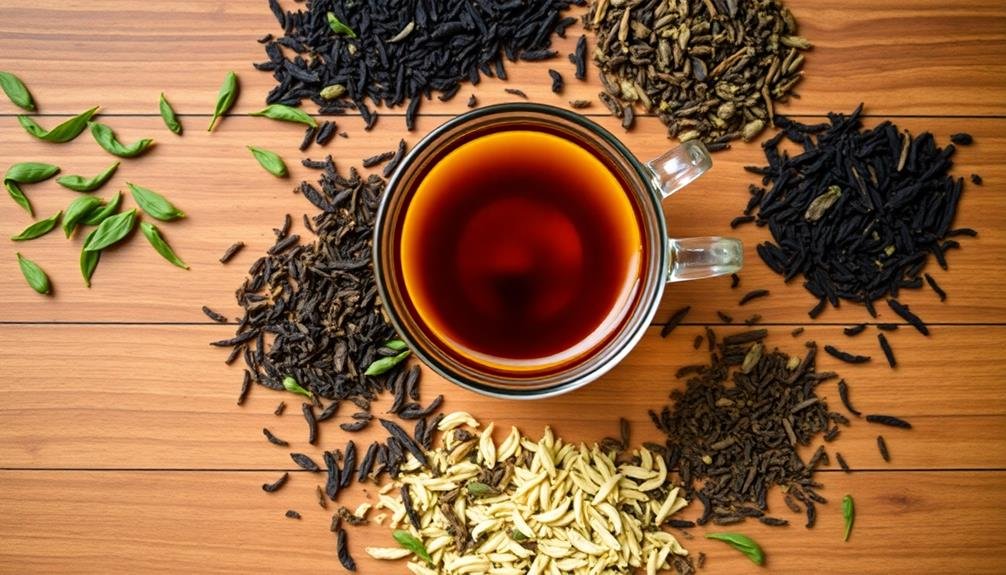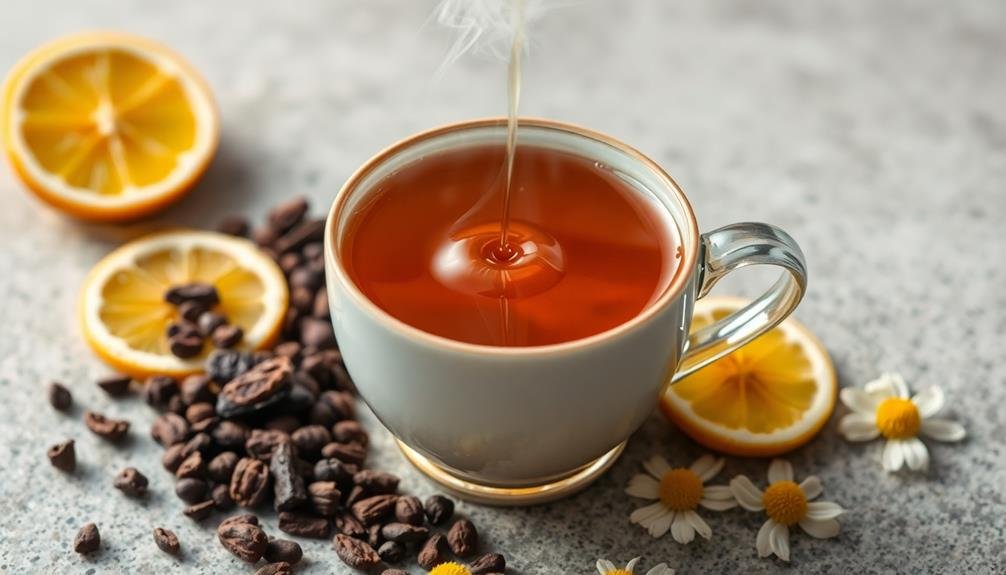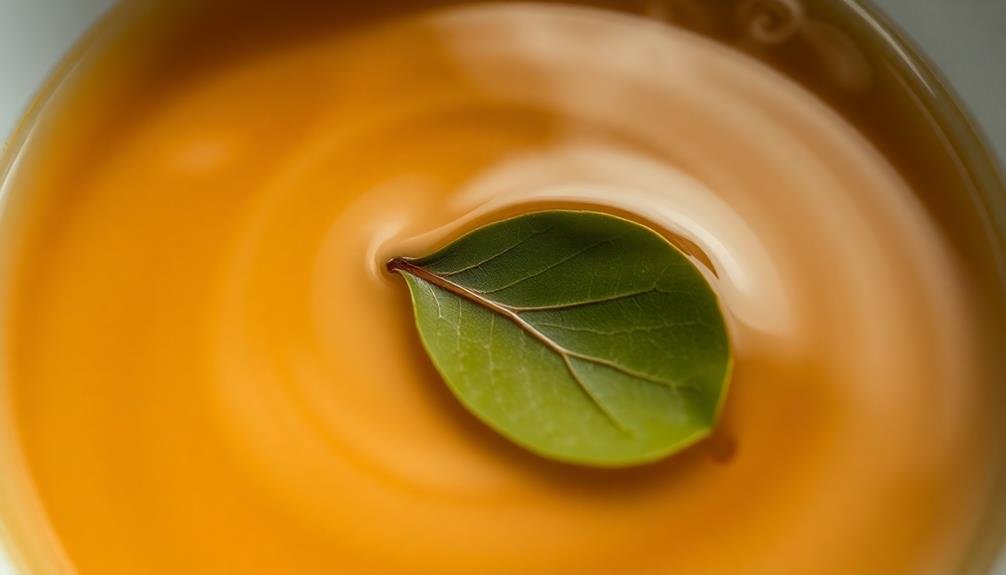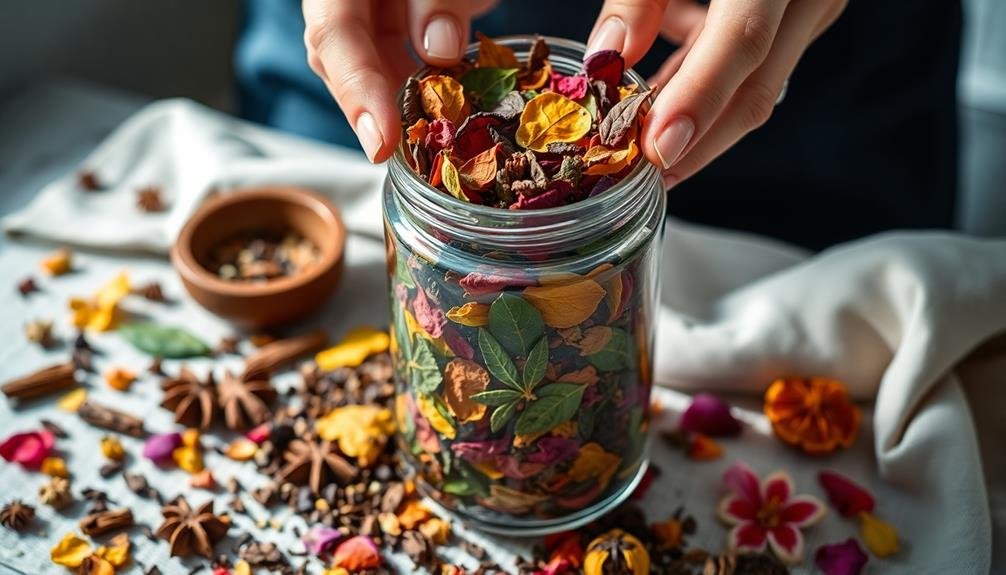To master tea blend complexity, you'll need to understand the nuances of flavor layering. Start by familiarizing yourself with base tea flavors, then explore complementary herb pairings. Balance sweetness and bitterness carefully, and incorporate aromatic additions for depth. Pay attention to texture and mouthfeel, considering how different ingredients interact. Adjust your blends seasonally, using fresh ingredients and adapting flavor intensity to the time of year. Experiment with various combinations, noting how each element contributes to the overall profile. As you refine your technique, you'll develop an intuition for creating harmonious and intriguing blends that tantalize the palate.
Understanding Base Tea Flavors

Immerse yourself in the world of tea blending by first mastering the foundation: base tea flavors.
To create complex blends, you'll need to understand the unique characteristics of different tea types.
Black teas offer robust, malty flavors with varying levels of astringency. They're often full-bodied and can range from sweet to smoky.
Green teas provide fresh, grassy notes with a subtle sweetness and sometimes a nutty undertone. Their flavor profile can be delicate or more intense depending on processing methods.
Oolong teas bridge the gap between green and black, offering a spectrum of flavors from light and floral to rich and roasted.
White teas are known for their subtle, delicate flavors with hints of sweetness and a smooth mouthfeel.
Pu-erh teas have earthy, sometimes mushroom-like flavors that develop complexity with age.
Complementary Herb Pairings
With a solid grasp of base tea flavors, you're ready to explore the world of complementary herb pairings. These pairings can elevate your tea blends, adding depth and complexity to your creations. When selecting herbs, consider their flavor profiles and how they'll interact with your base tea.
Some popular herb pairings include:
| Base Tea | Complementary Herbs |
|---|---|
| Black | Lavender, Cinnamon |
| Green | Mint, Lemongrass |
| Oolong | Ginger, Rose Petals |
| White | Jasmine, Chamomile |
To create a well-balanced blend, start with small amounts of herbs and adjust to taste. Remember that some herbs can overpower delicate tea flavors, so use them sparingly. Experiment with different combinations to find unique flavor profiles that suit your palate.
Don't limit yourself to traditional pairings. Try unexpected combinations like black tea with rosemary or green tea with sage. You'll discover exciting new flavors that can set your blends apart. As you practice, you'll develop an intuition for which herbs complement specific teas, allowing you to create more complex and nuanced blends.
Balancing Sweetness and Bitterness

You'll find that balancing sweetness and bitterness is essential for creating harmonious tea blends.
Consider complementary flavor profiles to achieve a well-rounded taste, pairing bitter elements with naturally sweet ingredients.
When it comes to sweetener selection, you can explore options like honey, stevia, or fruit pieces to enhance the overall flavor without overpowering the tea's natural characteristics.
Complementary Flavor Profiles
Countless tea blenders regard balancing sweetness and bitterness the cornerstone of creating complementary flavor profiles.
When you're crafting a blend, you'll want to identify teas with naturally sweet notes, like Fujian white teas or Taiwanese oolongs, and pair them with slightly bitter counterparts, such as Assam black teas or certain green teas. This contrast creates depth and complexity in your blend.
You can enhance complementary flavors by incorporating herbs, spices, or fruits. For instance, pairing a mildly bitter green tea with sweet, floral jasmine creates a harmonious balance.
Similarly, adding tart hibiscus to a naturally sweet rooibos can result in a well-rounded flavor profile.
Don't forget about texture when evaluating complementary flavors. A smooth, buttery oolong can be elevated by adding crunchy toasted rice or nuts.
You'll also want to reflect on how flavors evolve as you sip. A tea that starts sweet and finishes with a slight bitterness can be more intriguing than one with a uniform taste throughout.
Sweetener Selection Strategies
Selecting the right sweeteners can make or break your tea blend. When balancing sweetness and bitterness, consider the tea's natural flavors and how different sweeteners can enhance or overpower them. Start with a light touch, as you can always add more sweetness but can't take it away.
For delicate green or white teas, opt for mild sweeteners like honey or agave nectar. These won't mask the tea's subtle notes.
For robust black teas, you can use stronger sweeteners like brown sugar or maple syrup, which complement the bold flavors.
Herbal teas often pair well with fruit-based sweeteners like berry syrups or apple juice.
If you're working with a bitter tea, try stevia or monk fruit extract. These natural, zero-calorie sweeteners can counteract bitterness without adding calories.
For a unique twist, experiment with flavored simple syrups or infused honey. Lavender honey can elevate an Earl Grey, while ginger syrup can add depth to a chai blend.
Aromatic Additions for Depth
Tea's complexity can be greatly enhanced by incorporating aromatic additions. These fragrant elements add depth and nuance to your blend, creating a more sophisticated flavor profile.
Consider adding dried flowers like lavender, rose petals, or chamomile for a floral touch. Herbs such as mint, lemongrass, or thyme can introduce fresh, invigorating notes. Spices like cinnamon, cardamom, or star anise offer warmth and intensity.
When selecting aromatic additions, consider their compatibility with your base tea. Delicate green teas pair well with light, subtle aromas, while robust black teas can handle bolder additions. Experiment with different combinations to find unique flavor harmonies. Start with small amounts and gradually increase to achieve the desired intensity.
Don't overlook the power of citrus zest or dried fruit pieces. These can add brightness and natural sweetness to your blend. For an exotic twist, try adding vanilla beans or cocoa nibs.
Remember that some aromatics may lose potency over time, so adjust quantities accordingly when storing blends. By mastering the art of aromatic additions, you'll elevate your tea blends to new levels of complexity and enjoyment.
Texture and Mouthfeel Considerations

When crafting your tea blend, you'll need to contemplate the balance between astringency and body to achieve the desired mouthfeel.
You can create smooth profiles for a gentle sipping experience or opt for brisk textures that invigorate the palate.
Experiment with different ingredients to explore lingering sensations that leave a lasting impression after each sip.
Astringency and Body Balance
How do you achieve the perfect balance between astringency and body in your tea blend? It's all about understanding the characteristics of different tea types and how they interact. Astringency, the dry, puckering sensation in your mouth, comes primarily from tannins in tea leaves. Body refers to the tea's weight and fullness on your palate.
To balance these elements, consider the following:
- Choose your base tea wisely. Black teas often provide more astringency and body, while green teas are generally lighter.
- Experiment with brewing times and temperatures. Longer steeps increase astringency and body.
- Add complementary ingredients to counteract excessive astringency or boost body.
Here's a quick guide to common tea types and their astringency-body profiles:
| Tea Type | Astringency | Body |
|---|---|---|
| Black | High | Full |
| Green | Low-Medium | Light |
| Oolong | Medium | Medium |
| White | Low | Light |
| Pu-erh | Low | Full |
Smooth vs. Brisk Profiles
Texture and mouthfeel play essential roles in defining a tea blend's profile as smooth or brisk. When crafting your blend, consider how different teas contribute to the overall sensation in the mouth. Smooth profiles often result from teas with a creamy, velvety texture, while brisk profiles have a more assertive, crisp feel.
To create a smooth profile, you'll want to:
- Include teas with naturally smooth characteristics, like white teas or certain oolongs.
- Balance astringency with mellower components.
- Consider adding ingredients that enhance creaminess, such as chamomile or vanilla.
- Pay attention to brewing temperature and time to avoid over-extraction.
For a brisk profile, focus on teas that provide a lively, invigorating mouthfeel. Black teas, particularly those from Assam or Ceylon, can contribute to this sensation.
You can also experiment with adding small amounts of more astringent teas to increase the briskness without overwhelming the blend.
Lingering Sensation Exploration
Three key aspects of a tea blend's lingering sensation deserve exploration: aftertaste, mouthfeel evolution, and palate cleansing effects. When crafting your blend, consider how flavors persist after swallowing. Some teas leave a sweet, floral finish, while others impart a savory or astringent sensation. Experiment with herbs like licorice root or mint to enhance the aftertaste duration.
Mouthfeel evolution refers to how the tea's texture changes as you sip. Start by focusing on the initial impact, then observe how it transforms. You might aim for a smooth entry that develops into a full-bodied experience, or vice versa. Ingredients like marshmallow root can add a silky quality, while finely ground matcha creates a thicker texture.
Lastly, consider the blend's palate cleansing effects. Some teas, particularly those with astringent qualities, can refresh the mouth between sips. Others might coat the palate, creating a lasting impression. Balance these effects to achieve your desired lingering sensation, whether you're aiming for a clean finish or a prolonged flavor experience.
Seasonal Blending Strategies
Savvy tea blenders often adjust their creations to complement the changing seasons. You'll find that adapting your blends to match the weather and seasonal ingredients can elevate your tea-drinking experience.
To master seasonal blending, consider these key strategies:
- Embrace seasonal ingredients: Incorporate fresh, locally available herbs, fruits, and spices that are abundant during each season.
- Adjust flavor intensity: Create lighter, invigorating blends for summer and richer, more complex flavors for winter.
- Consider temperature preferences: Develop blends that can be enjoyed hot or cold, depending on the season.
- Align with seasonal activities: Craft blends that complement typical seasonal activities and celebrations.
When developing your spring blends, focus on light, floral notes with hints of new growth.
Summer calls for bright, fruity flavors and cooling herbs.
As autumn approaches, incorporate warm spices and harvest-inspired ingredients.
Winter blends should offer comfort with rich, full-bodied flavors and warming spices.
Don't forget to experiment with different base teas to find the perfect foundation for each seasonal blend.
Frequently Asked Questions
How Long Should Tea Blends Be Aged Before Consumption?
You don't always need to age tea blends before drinking. Some are ready immediately, while others benefit from a few weeks to several months of aging. It's best to taste-test periodically to determine your preferred flavor profile.
What Equipment Is Essential for Creating Professional-Quality Tea Blends at Home?
You'll need quality scales, airtight containers, and a tea infuser. Don't forget a notebook for recipes and a timer. Invest in a good kettle and thermometer. Spoons and sieves are helpful for mixing and sifting.
Can Tea Blends Be Used in Cooking or Baking?
Yes, you can use tea blends in cooking and baking! They'll add unique flavors to your dishes. Try infusing sauces, marinades, or desserts with tea. You can also use tea as a spice rub or in baked goods.
Are There Any Health Considerations When Creating Custom Tea Blends?
You should consider potential allergies and interactions when creating custom tea blends. Be aware of caffeine content, herbal effects, and medicinal properties. It's wise to research each ingredient thoroughly and consult a healthcare professional if you're unsure.
How Do Different Water Temperatures Affect the Flavor of Tea Blends?
Water temperature greatly affects your tea's flavor. You'll extract delicate notes with cooler water, while hotter temperatures release bolder flavors. It's essential to match the right temperature to your blend for best taste.
In Summary
You've now explored the art of tea blending, from understanding base flavors to creating seasonal variations. By mastering complementary pairings, balancing taste elements, and considering aromatics and texture, you're ready to craft complex, layered blends. Remember, it's all about experimentation and trusting your palate. Don't be afraid to break rules and create unique combinations. With practice, you'll develop your signature style and delight tea lovers with your innovative blends.





Leave a Reply